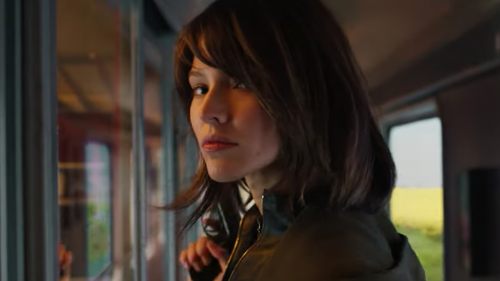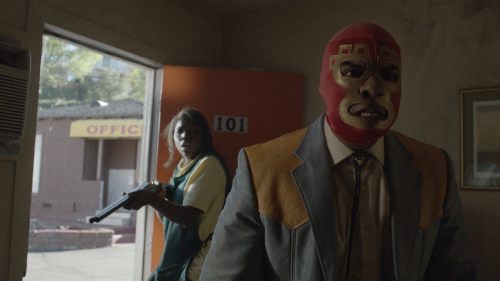VALERIAN Is The Movie Summer Cinema Needs, But Not The Movie It Wants
The last, fleeting moment of Earth-bound recognition in Valerian and the City of a Thousand Planets takes place in the first five minutes of the film’s runtime — a flashback scored to David Bowie’s "Space Oddity" that’s about all the exposition you’re going to get for the next two hours.
The dinky little International Space Station, floating perilously above the planet, hosts meetings between representatives of various terrestrial nations. In rapid succession, we see cuts to hundreds of years in the future, as actual, top-heavy, bulgy aliens make themselves known to humanity. From grainy 16mm footage to a gargantuan CGI ball of yarn that, when rendered in 3D, made my head bleed, metaphorically speaking.
By the end of this dizzying prologue, the narrative has zoomed past reality at light speed. Then, we’re on a planet filled with shiny, translucent creatures that seem like distant cousins of the Na’vi from Avatar mixed with the tall grays of urban legend. Oh, and a dog-rat hybrid that poops out tiny pinballs that could power an entire spaceship. If this was a newspaper review from, say, Green Bay, Wisconsin, I’d probably end this paragraph with something like “Houston, we have a problem” or “Beam me up, Scotty,” because for the moviegoer not versed in the more obscure fringes of science-fiction, the first 20 minutes of Valerian would test their patience and leave them incapable of communicating in anything other than cliché.
Based off the French/Belgian comic book series Valerian and Laureline, Luc Besson’s return to space opera makes no real attempt to explain or rationalize — not its tech, not its political intrigue, or even its reason for being. Modern blockbusters are usually eager to please — winks to source material, breezy jokes, wall-to-wall pop music, and all that. We all know that summertime cinema is product first and art second. Artistic endeavor is often messy or just plain terrible. Blockbuster moviemaking is almost always so competent that you get lost in it and forget for a moment where you even are. Seeing certain big budget films is akin to getting a deep tissue massage or listening to an ASMR video on YouTube.
Valerian is like getting slapped in the ass with a bedazzled lawn gnome. It’s either your thing or it isn’t, but you will remember it forever. As Hollywood wrings its hands over a perceived “franchise fatigue” and audiences beg for fresh ideas, Valerian offers that breath of fresh air people are craving. But what film fans and critics are really asking for usually isn’t something actively strange, it’s an old idea with a new coat of paint or a film like Baby Driver that taps into warm and fuzzy feelings of nostalgia and breathless teen romance. The only thing Valerian taps into is the boundless imagination of Luc Besson and the stories he was obsessed with as a child.
The source material, a favorite of Besson from his adolescence, is firmly rooted in the 1960s space age era from whence it came. Galactic cop Valerian and his far more competent partner Laureline travel through time and space righting wrongs and standing up for the egalitarian, utopian morals of a multi-species future government. In that sense, it was cut from the same cloth as Star Trek — heavy with message, but never quite didactic enough to become obnoxious. Besson’s film hews as closely to that template as possible, with Dan DeHaan’s Valerian striding through every scene with an arrogant smirk, while Cara Delevigne’s Laureline is his conscious, pushing him to be a better man.
We’ve seen that in sci-fi before, from Admiral Kirk and Carol Marcus in Star Trek II: The Wrath of Khan to Princess Leia and Han Solo in the Star Wars saga. In that sense, Valerian is not treading on new ground. It has much of the same problem that films like John Carter or Ghost in the Shell had to face. When what is being adapted has already been strip-mined for creative innovation, how can that literal adaptation end up feeling at all fresh? How can you create a truly groundbreaking Judge Dredd film after Paul Verhoeven already made one, but called it RoboCop?
What sets Valerian apart from all of that is Besson, who with his company EuropaCorp, has created an environment where he can experiment and make films that are true expressions of his particular joyful madness. It took EuropaCorp years and numerous investment sources to fully finance Valerian, and the finished product illustrates why. It’s as if this was a test to see how many alienating elements can be put into a movie that still gets a greenlight. Dialogue has never been Besson’s forte, and he does not disappoint, frequently shoving clunkers into a character’s mouth. By all rights, this film should not work. In many ways, it doesn’t. The tonal shifts are jarring, DeHaan makes for a fairly unremarkable protagonist, and it is aggressively weird.
What could be hokey in another filmmaker’s hands instead feels sincere and joyous when Besson gets involved. The Fifth Element was considered positively insane when it came out in 1997. Now, its most outré touches have become pop culture landmarks — Ruby Rhod, Leeloo Multipass, the Diva Plavalaguna whatever the hell Gary Oldman was up to, etc. Spoiler alert for a 20-year-old movie, but the freakin’ Fifth Element was love.
The imagination in this film is staggering, with the standout sequences coming not long after the rat-dogs pooping out pinballs. Valerian and Laureline are called on to break up an arms deal inside a tourist attraction called Big Market, which is a virtual reality mall. Well, not quite virtual, as it’s a real shopping district on a whole other planet, but because it’s so dangerous (think accidentally wandering into a red-light district in an Eastern European city), middle-class shoppers can only traverse it safely through advanced hologram technology. You’re there, but you’re not there at all.
This sequence is thrilling not for its incredible action or outrageous stunts, but because it’s a fully fleshed out sci-fi idea that isn’t explained or rationalized. It just is, and you’re thrown into it without the sort of tedious explanation that bogs down so many movies like this. That sense of invention is lacking in so many sci-fi films today, because most of them rely on intellectual property we’ve seen a million times. Fiddling with that technology or making it behave differently than we’re used to only serves to frustrate long-time fans. Think back to the outrage over Khan transporting from Earth to the Klingon homeworld without any transporter pad in Star Trek Into Darkness. It was a subversion of canon that didn’t really matter all that much, but because we know how transporters works and have known for 50 years, it’s aggravating. You will walk out of Valerian not knowing how anything works, which means it could feel like nothing more than nonsense magic, but much of the iconic technology in Star Trek (transporters, warp drive, holodecks, whatever it was keeping Shatner’s hairpiece on) is still closer to fantasy than reality, so the only difference is the writers have strung words together to make that magic seem real.
Valerian embraces some of the madness that is inherent in the sci-fi genre, or what that genre was in the days of pulpy comics and dusty paperbacks with scantily clad heroes running from phallic worm monsters in the desert on the cover. Maybe more charismatic leads could have helped critics swallow this pill a bit easier, like with Besson’s last film, the inscrutable but financially successful Lucy, starring Scarlett Johansson working overtime to sell a series of increasingly bizarre, illogical concepts. DeHaan and Delevigne have next to no chemistry and they don’t land most of the jokes in the script. Valerian has a more believable relationship with a blubbery blue cabaret dancer played by Rihanna who aids our heroes through the second act than his ostensible love interest. Delevigne doesn’t seem natural in the action hero role that Gal Gadot was so clearly comfortable with earlier this summer in Wonder Woman. The most memorable human performance in the entire movie comes from Ethan Hawke as a greased up space pimp that’s dressed like the lead singer of a '90s Stone Temple Pilots ripoff.
It sounds counterintuitive to say this, but look past the details and see the film as a unique experience and it becomes, like magic, a fun ride. At some point, you either learn to like the bedazzled lawn gnome or you don’t. The Fifth Element might not have been the biggest theatrical hit in America, but it was a huge hit overseas and has outlasted many of its contemporaries in the popular imagination. It was one of the first pieces of genre entertainment to make me see that there was a world outside of American pop culture. At a time in cinema history where everything feels derivative, Valerian just might serve that purpose for a brand new generation of young nerds. For that, I’m glad it exists.



